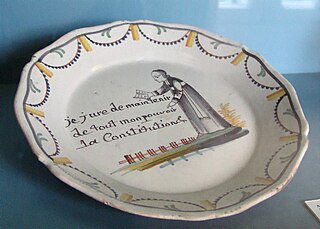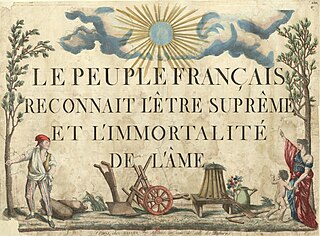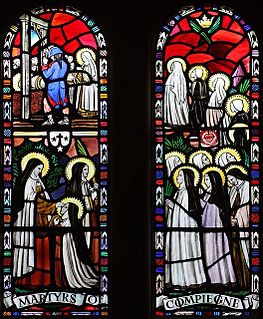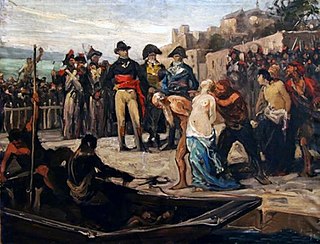 W
WThe Carmes Prison was a prison of the French Revolution. It was set up in what had been the Carmes Monastery in Paris. It formed a vast enclosure bounded by rue du Regard, rue du Cherche-Midi and rue Cassette - it was also bordered to the south by rue de Vaugirard. It was the site of one of the September Massacres in 1792 and features in the 1927 film Napoléon.
 W
WThe Civil Constitution of the Clergy was a law passed on 12 July 1790 during the French Revolution, that caused the immediate subordination of the Catholic Church in France to the French government.
 W
WThe Concordat of 1801 was an agreement between Napoleon and Pope Pius VII, signed on 15 July 1801 in Paris. It remained in effect until 1905. It sought national reconciliation between revolutionaries and Catholics and solidified the Roman Catholic Church as the majority church of France, with most of its civil status restored. The hostility of devout French Catholics against the revolutionary state had then largely been resolved. It did not restore the vast church lands and endowments that had been seized upon during the revolution and sold off. Catholic clergy returned from exile, or from hiding, and resumed their traditional positions in their traditional churches. Very few parishes continued to employ the priests who had accepted the Civil Constitution of the Clergy of the Revolutionary regime. While the Concordat restored much power to the papacy, the balance of church-state relations tilted firmly in Napoleon's favour. He selected the bishops and supervised church finances.
 W
WThe Cult of Reason was France's first established state-sponsored atheistic religion, intended as a replacement for Catholicism during the French Revolution. After holding sway for barely a year, in 1794 it was officially replaced by the rival Cult of the Supreme Being, promoted by Robespierre. Both cults were officially banned in 1802 by Napoleon Bonaparte with his Law on Cults of 18 Germinal, Year X.
 W
WThe Cult of the Supreme Being was a form of deism established in France by Maximilien Robespierre during the French Revolution. It was intended to become the state religion of the new French Republic and a replacement for Roman Catholicism and its rival, the Cult of Reason. It went unsupported after the fall of Robespierre and was officially proscribed when Napoleon restored Catholicism in France.
 W
WThe Decadary Cult or Tenth-day Cult was a semi-official religion of France during the Directory period of the French Revolution, intended to offer a non-Christian alternative after the dechristianisation of the country. It replaced the Christian Sunday worship with a quasi-religious festival on the day of rest in the 10-day week of the French Republican Calendar.
 W
WSaint-Étienne-des-Grès was a church and parish in Paris, France, formerly located in the Latin Quarter on the Rue Saint-Jacques.
 W
WTherese-Madeleine Fantou was a religious with the Daughters of Charity of Saint Vincent de Paul martyred during the French Revolution. She is recognized as a Blessed martyr by the Catholic Church.
 W
WJerusalem, or on Religious Power and Judaism is a book written by Moses Mendelssohn, which was first published in 1783 – the same year, when the Prussian officer Christian Wilhelm von Dohm published the second part of his Mémoire Concerning the amelioration of the civil status of the Jews. Moses Mendelssohn was one of the key figures of Jewish Enlightenment (Haskalah) and his philosophical treatise, dealing with social contract and political theory, can be regarded as his most important contribution to Haskalah. The book which was written in Prussia on the eve of the French Revolution, consisted of two parts and each one was paged separately. The first part discusses "religious power" and the freedom of conscience in the context of the political theory, and the second part discusses Mendelssohn's personal conception of Judaism concerning the new secular role of any religion within an enlightened state. In his publication Moses Mendelssohn combined a defense of the Jewish population against public accusations with contemporary criticism of the present conditions of the Prussian Monarchy.
 W
WMarie-Louise-Élisabeth de Lamoignon de Molé de Champlâtreux - in religion Saint-Louis - was a French Roman Catholic professed religious and the founder of the Sisters of Charity of Saint Louis (1803). Lamoignon dedicated herself to the education of both the poor and abandoned girls of her region though her love for the poor was noted during her marriage; this was something her politician husband also supported before he was executed during the French Revolution. That period bought great turmoil upon her coupled with the loss of two of her five children.
 W
WThe Martyrs of Compiègne were the 16 members of the Carmel of Compiègne, France: 11 Discalced Carmelite nuns, three lay sisters, and two externs. They were executed by the guillotine towards the end of the Reign of Terror, at what is now the Place de la Nation in Paris on 17 July 1794. They are the first martyrs killed during the French Revolution recognized as saints. They were beatified in 1902 and canonized in 1906. Their feast day is 17 July.
 W
WThe drownings at Nantes were a series of mass executions by drowning during the Reign of Terror in Nantes, France, that occurred between November 1793 and February 1794. During this period, anyone arrested and jailed for not consistently supporting the Revolution, or suspected of being a royalist sympathizer, especially Catholic priests and nuns, was cast into the Loire and drowned on the orders of Jean-Baptiste Carrier, the representative-on-mission in Nantes. Before the drownings ceased, as many as four thousand or more people, including innocent families with women and children, died in what Carrier himself called "the national bathtub".
 W
WRevolutionary France enacted laws that first emancipated Jews in France, establishing them as equal citizens to other Frenchmen. In countries that Napoleon Bonaparte's ensuing First French Empire conquered during the Napoleonic Wars, he emancipated the Jews and introduced other ideas of freedom from the French Revolution. For instance, he overrode old laws restricting Jews to reside in ghettos, as well as lifting laws that limited Jews' rights to property, worship, and certain occupations.
 W
WSaint-Étienne Church is a Roman Catholic parish church on rue de l'Étamine in the French city of Beauvais. It was founded in the late 3rd century by Firmin of Amiens and - though its original dedicatee is unknown - it was long dedicated to Saint Vaast d'Arras, with a chapter existing under this title from 1072 to 1742. The present church dates to the 12th century, but even before this was begun it was at the centre of medieval town life and one of the most importrant parishes in the city despite being outside the episcopal city.
 W
WA Temple of Reason was, during the French Revolution, a temple for a new belief system created to replace Christianity: the Cult of Reason, which was based on the ideals of reason, virtue, and liberty. This "religion" was supposed to be universal and to spread the ideas of the revolution, summarized in its "Liberté, égalité, fraternité" motto, which was also inscribed on the Temples. According to the conservative critics of the French Revolution, within the Temple of Reason, "atheism was enthroned". English theologian Thomas Hartwell Horne and biblical scholar Samuel Davidson write that "churches were converted into 'temples of reason,' in which atheistical and licentious homilies were substituted for the proscribed service".